Rededication of Leo Frank’s Memorial
A memorial to all victims of lynching is to be added in the coming months.
Dave Schechter is a veteran journalist whose career includes writing and producing reports from Israel and elsewhere in the Middle East.
In Deuteronomy is found the instruction: Justice, justice you shall pursue.
The rededication of a memorial was but one step in the decades-long campaign to gain justice for Leo Frank, who was lynched on Aug. 17, 1915, in the Marietta woods near where Roswell Road intersects Interstate 75 today.
The memorial, which the Georgia Department of Transportation had removed four years ago in preparation for road construction, now stands anchored in a sidewalk in a grassy area carved out by GDOT.
Those in attendance on the morning of August 23 came to remember the evil perpetrated a short distance away.
“Leo Frank was innocent. And those four words have eluded polite conversation in Atlanta and in Marietta for over a century,” declared Rabbi Steve Lebow of Temple Kol Emeth.
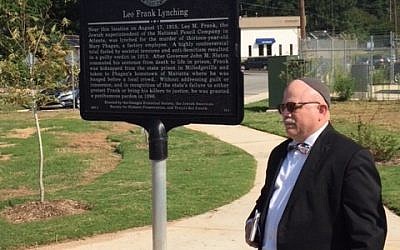
The memorial had been located across Roswell Road near Frey’s Gin Road, close to where Frank, the 31-year-old Jewish superintendent of a downtown Atlanta pencil factory, was hanged at daybreak, following his kidnapping overnight from the state prison in Milledgeville.
Frank was to have spent the remainder of his days there, after Gov. John Slaton, in one of his last acts in office, commuted the death sentence Frank received after a jury found him guilty of the April 26, 1913, murder of 13-year-old Mary Phagan, who worked at the factory.
Those planners and executioners of the lynching included leading citizens of Cobb County.
Lebow, whose Reform congregation is located a few miles from the memorial, is a vocal advocate for a complete exoneration of Frank, who was granted a limited pardon by the state in 1986, on the grounds that he was denied a fair trial and that the state failed to protect him in prison.
“You know, we have a saying, that ‘justice delayed is justice denied,” Lebow told the assembled. “And Frank has had his justice delayed. He’s still guilty in the official records of the state of Georgia. Yet every historian, every politician, and every prosecutor knows that Leo Frank was innocent.”
The restored memorial reads: “Near this location on August 17, 1915, Leo M. Frank, the Jewish superintendent of the National Pencil Company in Atlanta, was lynched for the murder of thirteen-year-old Mary Phagan, a factory employee. A highly controversial trial field by societal tensions and anti-Semitism resulted in a guilty verdict in 1913. After Governor John M. Slaton commuted his sentence from death to life in prison, Frank was kidnapped from the state prison in Milledgeville and taken to Phagan’s hometown of Marietta where he was hanged before a local crowd. Without addressing guilt or innocence, and in recognition of the states failure to either protect Frank or bring his killers to justice, he was granted a posthumous pardon in 1986.”
Below those words are listed the Georgia Historical Society, the Jewish American Society for Historic Preservation, and Temple Kol Emeth.
The placement of the memorial is a sign, Lebow said, that the state of the Georgia and the Georgia Historical Society “tacitly understand” that Frank was a victim, and not the killer. “So, we are slowly moving in our community to realize the horrors of lynching toward all, but also the ultimate exoneration of Leo Frank,” he said.
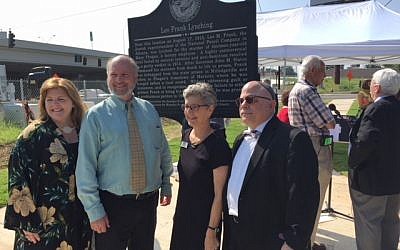
Following the ceremony, as a crepe myrtle tree provided by the Southeast regional office of the Anti-Defamation League was planted several feet from the memorial, some in attendance took their turn placing a shovelful of dirt into the hole.
Frank is buried at Mount Carmel Cemetery in the New York borough of Queens. His Atlanta-native widow, Lucille Selig Frank, never remarried and died in 1957, and her ashes are buried between her parents’ graves in the Oakland Cemetery in Atlanta.
A little more than two miles west of the Leo Frank memorial, in the Marietta City Cemetery, is the grave of Mary Phagan.
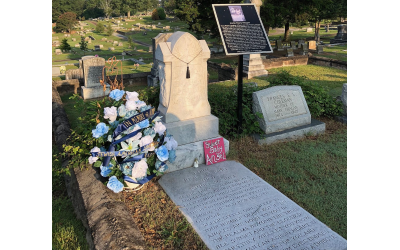
The organizers of the rededication ceremony – Lebow, the ADL, and Jerry Klinger, president of the Jewish American Society for Historic preservation – also ordered a floral wreath to be placed at Phagan’s gravesite.
A retired executive in the financial services industry, who lives in a Maryland suburb of Washington, D.C., Klinger has been Lebow’s partner in efforts to restore the memorial.
He called Lebow “a courageous individual” for his ongoing efforts on gaining Frank formal exoneration.
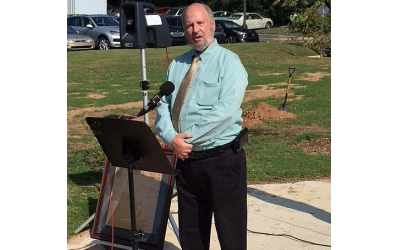
Klinger paid for the Leo Frank memorial, as he has done with markers in 30 states and five countries that recall noteworthy events and people in Jewish American history.
In his remarks, Klinger announced that GDOT has approved his plan to also place on that site a marker made of black Georgia marble that reads: “In respectful memory of the thousands across America denied justice by lynching; Victims of hatred, prejudice, and ignorance. Between 1880-1930, ~570 Georgians were lynched. ADL, Jewish American Society for Historic Preservation, Rabbi Steven Lebow, Temple Kol Emeth”
That memorial – which will be 36 inches tall, 14 inches wide at its base and six inches in depth – will be dedicated later this year.
“I realized we had an opportunity to transform the meaning of this location beyond Leo Frank, to transform it into something of national significance,” Klinger said, calling it the first memorial in the United States dedicated to all victims of lynching.
[Note: The National Memorial for Peace and Justice,” which opened April 26 in Montgomery, Ala., along with an accompanying museum, “is the nation’s first memorial dedicated to the legacy of enslaved black people, people terrorized by lynching, African Americans humiliated by racial segregation and Jim Crow, and people of color burdened with contemporary presumptions of guilt and police violence,” according to its website.]
In his remarks, attorney Dale Schwartz recounted the story of how the limited pardon was gained. In those years, as a member of the Anti-Defamation League’s Southeast Region board, Schwartz was the lead counsel for the pardon application process.
In 1982, 83-year-old Alonzo Mann, who had worked at the factory as a boy, told the Nashville Tennessean newspaper that he had seen another worker at the pencil factory, Jim Conley, carrying a girl’s limp body and that Conley had threatened him not to tell.
In December 1983, the Georgia Board of Pardons and Paroles rejected an appeal that Frank be exonerated, saying that his innocence could not be proved beyond a shadow of doubt.
On March 11, 1986, the board granted a posthumous pardon “without attempting to address the question of guilt or innocence and in recognition of the state’s failure to protect the person of Leo M. Frank and thereby preserve his opportunity for continued legal appeal of his conviction, and in recognition of the state’s failure to bring his killers to justice, and as an effort to heal old wounds.”
“Rabbi Lebow really has never let us slow down in trying to get Leo Frank exonerated,” said Schwartz, who today is a prominent immigration attorney.
“We hope that those who come to this green space in the future and read the story of the events that took place here in 1915 not only gain a greater understanding of what happened here but also come away with an understanding of the role that historical markers play as an educational resource,” said Patricia Meagher, communications director of the Georgia Historical Society.
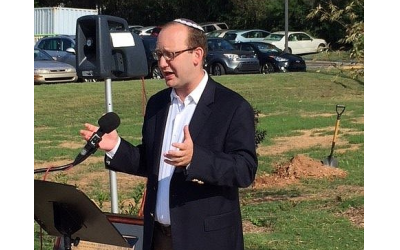
The memorial rededication ceremony began with a prayer by Rabbi David Dorsch of Congregation Etz Chaim and closed with a chanting of “El Maleh Rahamim” by Cantor Barbara Margulis and the Kaddish recited by Lebow.
Repercussions from the Leo Frank case were evident in the growth of the local Jewish community. There were about 4,500 Jews in Atlanta in 1910 and 11,000 a decade later. Not until 1980 did the Jewish population rise to 27,500. Today it’s estimated in the range of 130,000-plus.



comments